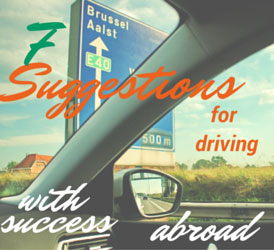7 Suggestions For Driving With Success Abroad

Tuesday 16 June 2015
7 Suggestions For Driving With Success Abroad
Talk to anyone who has hired a car or taken their own abroad, and they'll tell you it's an experience that will deliver it's fair share of surprises, and maybe even the occasional scare! There will be many times when you will feel lost when driving far from home, but survive the ordeal and you'll be certain to come out the other end a much better driver. If you're considering taking it up for the first time, or just could do with a helpful reminder, then our handy tips will give you all the key information you'll ever need...
- Expect the unexpected
- Familiarise yourself with the road signs
- Have the right documents with you
- Stay away from city centres
- Bring along the correct kit
- Take Regular Breaks
- Exercise some common sense
There's only way to approach driving in a new country - and that's with extreme caution! Firstly, always be aware of your position on the road. Most countries on mainland Europe drive on the right-hand side of the road, whilst in the UK, cars travel on the left. Bear this in mind when taking on roundabouts. Buy a good SAT NAV and/or Maps if you haven't already, and remember to download the most up-to-date maps to your SAT NAV to limit the chance of travelling up roads that lead to nowhere.
Keep an eye out for road signs and traffic lights. Road signs may look the same across Europe but each country will differ slightly, so don't let this throw you off.Obey the speed limit. In Italy for instance fines are particularly heavy for speeding offences. Each country speed limit will vary but the standard speed limits across Europe are 50km/h for built-up areas, 90km/h for outside built-up areas on ordinary roads, 110km/h on dual carriageways and 130km/h on motorways.
When driving, make sure you have your licence with you, along with a International driving permit (IDP). Be sure to have the relevant insurance and breakdown cover in place too. Contact your motor insurer before you leave to make sure you have the required cover when driving abroad.
Park your car and use public transport or taxis, rather than face driving in a city centre that you have never encountered. To save yourself time use motorways. You're likely to encounter toll roads on your motorway travels. Most countries in Europe will ask you to buy a special sticker or vignette, when driving on toll roads, which should be placed on your car's front window. Failure to display a valid vignette will result in a fine. If you're feeling brave and decide to take on driving in the city centre, try to avoid heavy traffic times and most important of all, stay calm. When you find yourself boiling over, resist the temptation to blast your car horn. In urban areas in Spain sounding the horn at any time, except in an emergency, is strictly prohibited. Lights may be flashed in place of using the horn.
In many countries in mainland Europe, it is compulsory for all vehicles with more than two wheels to display a warning triangle. Drivers must also store a reflective jacket in their vehicle and not in the boot (it must be worn when exiting the vehicle so therefore must be kept within the car), which has to be worn in the event of a breakdown or emergency outside a built up area. Some other countries require you to carry a First-aid kit as well as a set of replacement bulbs and fuses.
Driving in unfamiliar areas and concentrating on road signs can be exhausting. Be wise and pull up in a safe place to rest if you are feeling tired.
Don't forget basic safety. Ensure everyone is wearing their seatbelt, including you. Try not to get distracted by your SAT NAV whilst navigating your way around and resist the temptation to talk on your mobile whilst at the wheel.
So what's your opinion on driving in a new country? Do you embrace it, or do you try to avoid it? Let us know your thoughts by sharing your comments on our Facebook page.

 Free Cancellations Book now, cancel later. Over 90% of car parks can be cancelled for free 24 hours before arrival.
Free Cancellations Book now, cancel later. Over 90% of car parks can be cancelled for free 24 hours before arrival.